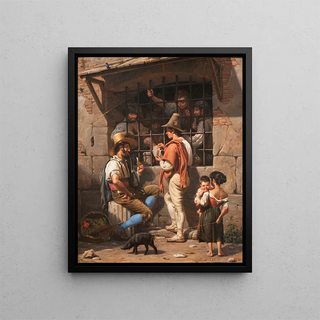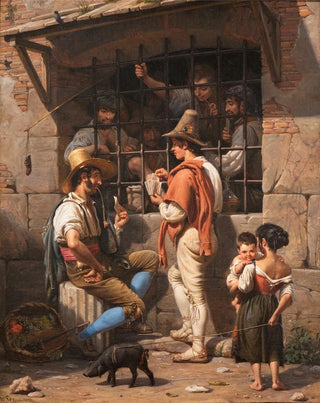Art print | Prison scene in Rome - Wilhelm Marstrand Source: Reproduction | Scène de prison à Rome - Wilhelm Marstrand


View from behind

Frame (optional)
Reproduction Scene of Prison in Rome - Wilhelm Marstrand – Engaging Introduction
The art print "Scene of Prison in Rome" by Wilhelm Marstrand transports us into a universe filled with emotion and reflection. This piece, both striking and evocative, immerses us in the intimacy of a moment of detention, where the gaze wanders through the details of a scene imbued with melancholy. Through this work, the artist invites us to contemplate not only the human condition but also the subtleties of social interactions. The subdued light filtering through the bars, the play of shadows and highlights—all contribute to creating an atmosphere that is both oppressive and fascinating, encouraging us to explore the hidden stories behind each character.
Style and uniqueness of the work
Marstrand's style is distinguished by its poignant realism and his ability to capture moments of life with rare intensity. In "Scene of Prison in Rome," every detail is carefully crafted, from the expressions of the characters to the textures of the prison walls. The artist employs a palette of dark colors, emphasizing the feeling of isolation and despair. The human figures, although frozen in a difficult situation, exude an emotional depth that transcends mere visual representation. The postures, gestures, and even the gaze of the protagonists tell a much broader story than what might be perceived at first glance. This work is not limited to a simple illustration; it becomes a true mirror of souls, revealing inner struggles and unfulfilled aspirations.
The artist and his influence
Wilhelm Marstrand, a prominent figure of 19th-century Danish art, established himself through his talent and unique vision. Trained at the Royal Danish Academy of Fine Arts in Copenhagen, he developed a style that skillfully combines realism and romanticism. Marstrand was inspired by his travels across Europe, especially in Italy, where he closely observed daily life and human dramas. His work is often marked by a strong narrative dimension, and "Scene of Prison in Rome" is a perfect example. Through his compositions, he seeks to raise social awareness and provoke reflection on the injustices of the world. His influence endures,

Matte finish

View from behind

Frame (optional)
Reproduction Scene of Prison in Rome - Wilhelm Marstrand – Engaging Introduction
The art print "Scene of Prison in Rome" by Wilhelm Marstrand transports us into a universe filled with emotion and reflection. This piece, both striking and evocative, immerses us in the intimacy of a moment of detention, where the gaze wanders through the details of a scene imbued with melancholy. Through this work, the artist invites us to contemplate not only the human condition but also the subtleties of social interactions. The subdued light filtering through the bars, the play of shadows and highlights—all contribute to creating an atmosphere that is both oppressive and fascinating, encouraging us to explore the hidden stories behind each character.
Style and uniqueness of the work
Marstrand's style is distinguished by its poignant realism and his ability to capture moments of life with rare intensity. In "Scene of Prison in Rome," every detail is carefully crafted, from the expressions of the characters to the textures of the prison walls. The artist employs a palette of dark colors, emphasizing the feeling of isolation and despair. The human figures, although frozen in a difficult situation, exude an emotional depth that transcends mere visual representation. The postures, gestures, and even the gaze of the protagonists tell a much broader story than what might be perceived at first glance. This work is not limited to a simple illustration; it becomes a true mirror of souls, revealing inner struggles and unfulfilled aspirations.
The artist and his influence
Wilhelm Marstrand, a prominent figure of 19th-century Danish art, established himself through his talent and unique vision. Trained at the Royal Danish Academy of Fine Arts in Copenhagen, he developed a style that skillfully combines realism and romanticism. Marstrand was inspired by his travels across Europe, especially in Italy, where he closely observed daily life and human dramas. His work is often marked by a strong narrative dimension, and "Scene of Prison in Rome" is a perfect example. Through his compositions, he seeks to raise social awareness and provoke reflection on the injustices of the world. His influence endures,






